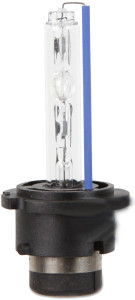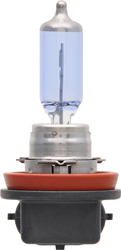Are HID kits legal
HID kits are illegal if you plan to install them in your halogen headlight assembly
Many people want to know if HID kits are legal because they want to retrofit their halogen headlights with them. If you’re one of those people, listen Up!
It is not illegal to manufacture HID conversion kits. It IS illegal to convert a headlight assembly that was made for halogen light bulbs. Those headlights were certified by the D.O.T for a halogen bulb and meet Federal lighting standards for beam focus and light output. Those Federal regulations aren’t just some namby pamby rules. They’re in place for a reason. If you ignore this and install HID bulbs and the glare from those bulbs interfere with another driver’s vision, causing an accident, YOU will be held liable.
Aside from the legal ramifications, it’s a STUPID idea. Read this article to understand why it’s not only a bad idea but will actually give you worse nighttime vision.
The Department of Transportation has rigorous standards for headlight assemblies. The regulations detail the beam pattern required for high and low beams. Once a headlight assembly is designed and approved for a particular type of bulb, it is illegal to retrofit it with a different bulb. Read the D.O.T letter at the end of this story and read about the legal liability issue here. The lawsuit mentioned is about tail-lights, but the liability issue is the same: If you change the lighting from factory and it causes an accident you are liable.
Many people buy high intensity discharge (HID) aftermarket kits that claim they’ll retrofit into existing headlight assemblies. Well, they may fit, but they’re not legal if the original assembly was approved for halogen bulbs.
What’s the deal with HID bulbs
Ok, so you’re willing to skirt the law and risk a ticket and you want to know what the big deal is, right? Well, since the original headlight assemblies were designed for a specific halogen bulb, the focal point of the reflector is curved in such a way as to maximum beam pattern and brightness for that particular bulb. A halogen bulb is shorter than an HID bulb. So the second you install the HID bulb, you change the focal point and beam pattern. The HID bulb flattens and widens the beam, sending more glare out the sides of your headlight and throwing that glare right into the eyes of oncoming traffic. Because the reflector isn’t designed for the longer bulb, retrofitting with HID bulbs actually casts LESS light on the road—defeating the whole purpose of converting to HID. Yeah, you read that right. You’ll see WORSE with an HID retro-fit kit than you did with the original halogen.
And, because the beam pattern is different than the halogen bulbs, HID kits often cause glare to oncoming traffic and THAT’s how you get caught by the police. The glare gives you away.
Next, since HID bulbs run at a higher temperature, you risk melting or at least distorting the lens and reflector in your headlight assembly. Don’t kid yourself, most factory headlights are molded from plastic. Expose them to too much heat and they distort, giving you EVEN LESS light. Doesn’t that sound like fun?
Retrofitting with HID exposes you to legal liability
The glare you throw into oncoming traffic can cause accidents. If your HID retrofit bulbs cause glare and that glare causes an accident, YOU can be sued for not having compliance headlights. Oregon State Police Senior Trooper Douglas Brown states, “I’ve had cases where they’ve swerved across into the oncoming lanes and hit the car that was blinding them.”
HID kits notoriously unreliable
HID lights aren’t typical light bulbs. They’re more like fluorescent bulbs where two electrodes energize a  gas inside the tube. To build enough voltage to “ignite” the gas, HID kits utilize a ballast—similar to the kinds used in fluorescent light fixtures. When you install an HID kit, you install the ballast near the headlight where it’s exposed to road splash, cold, and heat. You can buy an HID kit for as little as $100 for two bulbs, wiring harness, and ballast. The selling dealer makes about 50% profit on the kit. The manufacture has to limit manufacturing costs to about $10 to justify ship it and make a profit. So you can imagine how little quality you’re getting. So don’t be surprised if the ballast burns up within the first six months.
gas inside the tube. To build enough voltage to “ignite” the gas, HID kits utilize a ballast—similar to the kinds used in fluorescent light fixtures. When you install an HID kit, you install the ballast near the headlight where it’s exposed to road splash, cold, and heat. You can buy an HID kit for as little as $100 for two bulbs, wiring harness, and ballast. The selling dealer makes about 50% profit on the kit. The manufacture has to limit manufacturing costs to about $10 to justify ship it and make a profit. So you can imagine how little quality you’re getting. So don’t be surprised if the ballast burns up within the first six months.
Is there an alternative?
Many companies make blue bulbs to give the look of HID. But most of those have a painted blue coating. Sylvania makes a combo bulb that incorporates light filtering properties into the bulb to filter out the yellow characteristics of a tungsten bulb and give you a blue cast. Plus, they add a bit of xenon gas.  The bulbs cost about $50 for a pack of two and I’ve tried them. They put out more light than regular halogen bulbs, and the light is whiter, so I see better at night.
The bulbs cost about $50 for a pack of two and I’ve tried them. They put out more light than regular halogen bulbs, and the light is whiter, so I see better at night.
Here’s a legal interpretation of the law from the legal counsel of the National Highway Traffic and Safety Administration:
Here’s the link if you want to verify this
Mr. Simon S. Shih
4 Teal
Irvine, CA, 92604
Dear Mr. Shih:
This responds to your e-mail, in which you seek clarification regarding the legality of high intensity discharge (HID) headlamp conversion sets, specifically whether it is legal to manufacture or sell sets of HID headlamps to replace original equipment halogen headlamp sets. We are pleased to have the opportunity to answer your questions related to Federal Motor Vehicle Safety Standard (FMVSS) No. 108, Lamps, Reflective Devices and Associated Equipment.
By way of background, the National Highway Traffic Safety Administration (NHTSA) is authorized to issue FMVSSs that set performance requirements for new motor vehicles and items of motor vehicle equipment. As a preliminary matter, we would clarify that we have no authority either to approve or disapprove motor vehicles or items of motor vehicle equipment. We do advise correspondents of the relationship of their products to applicable FMVSSs and other regulations that we administer. If a product is covered by one or more of our safety standards, its manufacturer must certify compliance of the product with all applicable FMVSSs prior to its importation or offering such product for sale. The symbol “DOT” on replacement lighting equipment is often mistaken for “DOT approval” of the equipment, but, in fact, it reflects the manufacturer’s own certification of compliance.
We believe that your questions are addressed by our March 13, 2003, letter of interpretation to Mr. Galen Chen (see enclosure). In that letter, we interpreted FMVSS No. 108 as requiring headlamps manufactured to replace original equipment headlamps to comply with all applicable photometry requirements using the replaceable light sources intended for use in the headlighting system on the vehicle for which the replacement headlamp is intended. Unlike other lamps, FMVSS No. 108 specifically regulates headlighting systems, including their light sources (see S7.1, S7.5, and S7.7). We adhered to this interpretation in a recent interpretation to Calcoast-ITL (69 FR 60464 (Oct. 8, 2004))(see enclosure).
Because replaceable light sources are, by regulation, designed to be non-interchangeable, it would not be possible for an HID headlamp conversion set to meet the standard’s photometry requirements for an original equipment headlamp system using a halogen light source, so the replacement lamps could not be sold for this purpose. Furthermore, a headlamp dealer or motor vehicle repair business could not remove the original halogen headlamps and install HID replacement headlamps without violating 49 U.S.C. 30122. That section prohibits manufacturers, distributors, dealers, and motor vehicle repair businesses from making inoperative equipment installed in accordance with a Federal motor vehicle safety standard. We cannot comment on the specific replacement lighting products that you mentioned because we do not have sufficient information on them.
Finally, in a subsequent e-mail, you asked whether our regulations require HID lighting systems to include “auto-leveling” and washing systems, similar to those incorporated in vehicles sold in Europe. The answer is no. FMVSS No. 108 does specify aimability performance requirements under paragraph S7.8 of the standard, but that paragraph does not require an “auto-leveling” capability. The standard also does not contain any requirement for a headlamp washing system.
s it may be of interest to you, we also have enclosed a copy of our November 18, 2002, letter of interpretation to Mr. Jeff Deetz, which relates to kits that substitute the type of light source in existing headlamps.
I hope you find this information useful. If you have further questions, please feel free to contact Eric Stas of my staff at this address or by telephone at (202) 366-2992.
Sincerely,
Jacqueline Glassman
Chief Counsel
enclosures
ref:108
d.11/2/04
© 2012 Rick Muscoplat
Posted on by Rick Muscoplat
